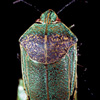 |
29.
Red Swamp Crawfish / `opae pake
First introduced into taro patches near Ahuimanu Stream, O`ahu in 1923,
Procambarus clarkii have become established throughout most of
the Hawaiian Island chain. Crayfish are abundant in freshwater along the
south shore of O`ahu, but were only collected near areas of tidal influence
in Nu`uanu and Manoa/Palolo Streams.
Crayfish populations apparently exploded after their introduction into
Hawa`ii, and by 1940 they had become serious pests to taro cultivation.
In Hawai`i, crayfish have been documented to consume taro, prey on insects
and snails, and their burrows can cause the draining of taro fields, or
lo`i. Chemical controls, such as the treatment of taro fields with
para-dichloro benzene (PDB) or napthalene were used from 1940 to 1952
to control crayfish depredations with over 1,417 ha of wetland taro fields
treated in Hawai`i.
Crayfish are still abundant throughout aquatic habitats on O`ahu, and
there has been no active Hawai`i control program since 1952. In California,
the introduction of P. clarkii and other introduced crayfish species
has caused the displacement of native aquatic species. Although not studied
in Hawai`i, the effects on native fish and other aquatic species may be
profound. Procambarus clarkii is also a vector for several harmful
human parasites including the lung fluke, Paragonimus westermani,
and the rat lungworm Angiostrongylus cantonensis.
|

 GOOD GUYS & BAD GUYS
GOOD GUYS & BAD GUYS 


 GOOD GUYS & BAD GUYS
GOOD GUYS & BAD GUYS 


